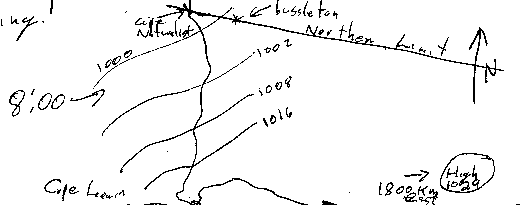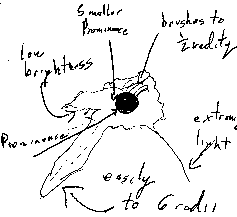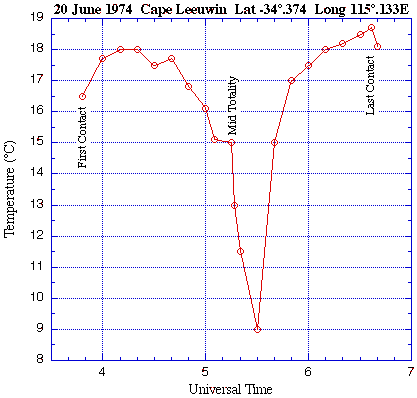The following account of
the Total Solar Eclipse of 20 June 1974 from Cape Leeuwin, South West
Australia
is a verbatim transcription from my observing notebook. In places
it is terse, but this was written in situ, and in real-time during the
eclipse - which we did indeed see.
"Which Way Did the Shadow
Bands
Go?"
and
"The Dog, the Sea Gulls, and the Jackass"
OBSERVING NOTEBOOK SUPPLEMENT
TOTAL SOLAR ECLIPSE
JUNE 20, 1974
CAPE LEEUWIN, SWA
All times local except when noted.
JUNE 20
 8:00
- Weather looks disgusting. I called Bureau of Meteorology in
Perth
($3.10 Australian). 20 minute call. There appears to be a line of
stratus clouds from the zenith (Augusta) up to the northern limit,
approximately
50 miles in width (see map), isobaric lines indicated. Wind from
320 at 15 knots. Chief forecaster suggests remaining at the Cape
as clouds should be past us (south) in 3 1/2 hours. However, if
they
are not we should move east. There is no way we can as there is
no
coast road. "No matter what happens, the our satellite picture
shows
you will definitely be under high thin cirrus. It's 6 of 1, half
dozen of the other".
8:00
- Weather looks disgusting. I called Bureau of Meteorology in
Perth
($3.10 Australian). 20 minute call. There appears to be a line of
stratus clouds from the zenith (Augusta) up to the northern limit,
approximately
50 miles in width (see map), isobaric lines indicated. Wind from
320 at 15 knots. Chief forecaster suggests remaining at the Cape
as clouds should be past us (south) in 3 1/2 hours. However, if
they
are not we should move east. There is no way we can as there is
no
coast road. "No matter what happens, the our satellite picture
shows
you will definitely be under high thin cirrus. It's 6 of 1, half
dozen of the other".
8:40 - After a conference with Mark, Craig, Barry,
and
Carter we decided to head for the lighthouse but keep the bus pointed
north
with the motor running.
9:00 - Well, we've arrived at the lighthouse, and
staked
our claim. The activity is low as most people have gone to the
Augusta
air strip. It is completely overcast now. From this
location
we hope to see the shadow come in over the Indian Ocean and leave over
the Antarctic Ocean.
9:40 - I've met some people from Mass., who were on
the
Canberra last year. I have begun to set up my equipment (I can
hope
can't I?).
10:10 - CAPE LEEUWIN: Latitude -34.347,
Longitude
115.133E
The Questar is set up and loaded with
Kodachrome-64.
The force fed spectrograph (for flash spectrum) is properly aligned.
EFL
= 600/150mm with/and without 3rd element. Film: K-X.
Grating
28,00 lines/inch.
10:25 - I have just finished setting up the
motorized
Nikon (250 {Exposure} back) with the 400mm lens. All tripods are
now weighted with rock bags with about: 75lbs - Questar; 50 lbs -
400mm;
25-30lbs - spectrograph. A suitable location has been found for
recording
air temperature. WAIT!! ->
10:30 - The edge of the stratus clouds is visible
above
the hills to the north. I estimate 25-30 miles away. The
sky
is beautifully blue beyond.
10:45 - It is now about 1 hour before first
contact.
The edge of the cloud layer is 20° above the horizon. There
is
light - extremely light - cirrus beyond. There is no doubt, with
the clouds moving the way they are we will definitely see it. The
rest of the expedition is coming out of the bus to set up. Even
Mark!
11:20 - The edge of the clouds is now
45°-50°
above the horizon, however scattered clouds beyond are preventing us
from
seeing the Sun clearly.
11:30 - The last of the bulk of scattered clouds has
moved
past the Sun's altitude (31°), and I have the solar disk in my 3
instruments.
The spectrograph is displaying a brilliant continuum spectrum.
There
is one major sunspot group about 2/3 the way from the edge.
11:48:20 - FIRST CONTACT! CLEAR SKIES!
YAHOO!
11:50 - First contact came slightly later than
expected.
Perhaps this is an observational error, but that is hardly likely since
myself and Peggy Jacobi disagree by only 2 seconds (I was
earlier).
Timing was made by Carter Roberts watch, which was constantly checked
with
observatories along the way. Since leaving L.A. it has gained 1
second.
At 1st contact the shaded air temperature was 16.5°C.
12:00 - Still same very thin scattered clouds, nut
the
"edge" of the main cloud bank is at our zenith. No doubt about a
successful eclipse.
12:15 - 3rd exposure of ingress shot through
Questar,
all exposures are 1/125 second. There is no noticeable change in
brightness or temperature yet. The people (locals and Perthites)
are lined up at the Questar for a peek at the Sun. I have been
distributing
aluminized mylar, and it's going like hot cakes.
12:35 - Clouds? What clouds? That's behind us
now.
Blue skies above. I am now putting an eyepatch over my left
eye.
I may look like Moshe Dyan, but the old dark adaption trick worked in
'70
and '73 (forget Cap Chat, it's a dirty word).
12:45 - Less than a half hour to go. While
there
is no real temperature drop yet the ground level wind has picked up a
bit.
And, a few people are sprouting blankets. The landscape is
beginning
to take on an eerie cream color.
1:00 - This will be my last entry until after
totality.
Things are really moving fast now. It is rapidly cooling, or so
it
seems. Everything is a creamy silvery color. By now Craig
Small
on the 727 must know what the corona looks like.
1:25 - WOW!

Before any details:
WE SAW IT FANTASTIC!!!!!!
BEST CORONA YET.
BEATS 70, 73 hands down.
I am now 3 for 4; 70, 72,
73, 74!!!
1:28 - I want to get this down before I
forget!
From 1:00 until second contact everything did move so fast, I had no
time
to write. At 1:05 the sky grew noticeably darker every
minute.
Creamy is not the right word for it.
At 1:10 the edge of the shadow could be easily seen
at
the horizon, steadily progressing over the Ocean. The sky grew
dark,
as dark a sky as I've been under during an eclipse save for the rain in
'63. There was not any diamond ring at second contact nor any
shadow
bands. The chromosphere was visible for about 12 seconds,
and
naked eye prominence visible 15° above the contact tangent
point.
The corona, for lack of an appropriate word, was magnificent.  A
large streamer to 4 radii was seen at 7:30 (position). One minute
into totality I ripped off my eyepatch and screamed my bloody head off
as I saw it grow to 6 1/2 radii . A bit to the north was a
noticeable
region of low brightness, and north of that {@} 10:30 a coronal loop
(broken)
which seemed to be associated with the prominence mentioned earlier.
->
I just took another partial eclipse picture (1:36). Getting back
to totality <- both horizons glowed red at mid totality. The
northern
horizon was more of a pink-orange color. Many fine streamers
could
be detected visually. I fired about 150 pictures with the motor
drive,
including 15 manually, up to 3 1/2 second exposures. Flash
spectra
were hopefully obtained (2) at second contact - I hope {NYIT} is happy
with the results!
A
large streamer to 4 radii was seen at 7:30 (position). One minute
into totality I ripped off my eyepatch and screamed my bloody head off
as I saw it grow to 6 1/2 radii . A bit to the north was a
noticeable
region of low brightness, and north of that {@} 10:30 a coronal loop
(broken)
which seemed to be associated with the prominence mentioned earlier.
->
I just took another partial eclipse picture (1:36). Getting back
to totality <- both horizons glowed red at mid totality. The
northern
horizon was more of a pink-orange color. Many fine streamers
could
be detected visually. I fired about 150 pictures with the motor
drive,
including 15 manually, up to 3 1/2 second exposures. Flash
spectra
were hopefully obtained (2) at second contact - I hope {NYIT} is happy
with the results!
Near mid-totality I looked around the sky for 15
seconds.
Acanar, Sirius, Canopus, the dimmest star I could see was Rigel and
this
only with averted vision! I was unable to pick up Saturn or
Mercury,
though. Oh, yes, Venus became visible 5 minutes prior to
totality.
The sky transparency was excellent, not even any cirrus clouds near the
Sun.
As 3rd contact approached the chromosphere became
visible
for about 18 seconds. An then - A beautiful diamond ring, the
classic
text book type. After 4 seconds it broke up into two beads.
My motorized camera began firing 20 seconds beforehand at 2
frames/second
1/60 sec exposures. I was busy with the spectrograph and couldn't
take any pictures {of 3rd contact} with the.
 Shadow
bands were seen after 3rd contact for 20-25 seconds, but were extremely
weak. The contrast was too low to determine speed or width.
They looked more like the projected image of a heat wave rising from a
radiator by a window. They were perhaps 1/2 a stop in contrast
between
the dark and light. But, here's the problem. Carter Roberts
and Myself definitely saw them moving AWAY from the sun on a sheet of
paper
(11.5"x24"). We were in front of the bus Sally Diecke and
Barrette
Brick, located to the left of the bus swear they saw them moving TOWARD
the Sun! Both of us can't be right, unless, they were moving
clockwise
around the bus. But *I* know what I saw - AWAY!
Shadow
bands were seen after 3rd contact for 20-25 seconds, but were extremely
weak. The contrast was too low to determine speed or width.
They looked more like the projected image of a heat wave rising from a
radiator by a window. They were perhaps 1/2 a stop in contrast
between
the dark and light. But, here's the problem. Carter Roberts
and Myself definitely saw them moving AWAY from the sun on a sheet of
paper
(11.5"x24"). We were in front of the bus Sally Diecke and
Barrette
Brick, located to the left of the bus swear they saw them moving TOWARD
the Sun! Both of us can't be right, unless, they were moving
clockwise
around the bus. But *I* know what I saw - AWAY!
-> Time for another picture - 1:45. the sky
is brightening
again, and loosing its creamy appearance. It was really cold a
while
ago <-
After 3rd contact, glancing back & forth from the
shadow band sheet to the Sun, the corona was visible for about 20
seconds
by occulting the emerging Sun with my thumb. The edge of the shadow was
seen speeding away out over the Ocean, toward the awaiting groups at
D'Entrecasteau,
Walpole, and Albany. Again, Venus was seen for 4 1/2 minutes before it
blended into the somewhat feeble daytime sky.
At 1:25 Mark popped the first bottle of Champaign
and
presented me with the cork, an honor I am told. Let's get up to
the
present:
1:55 - The sky appears to be at its normal
illumination
again. Some people are taking down equipment already but I'll
stick
it out till contact IV. Its funny, during a partial eclipse
everyone
watches until the end. But {with} a total, after totality forget
it. It's noticeably warmer now, I think I'll throw my sweater in
the bus.

2:10 - I forgot to mention at second contact a dog
began
to howl. At 3rd a whole flock of sea gulls lifted off the rocks
(about
200 I estimate). But 2 minutes into the eclipse {totality} some
jackass
came driving up the lighthouse road with his headlights glaring.
It's a good think I didn't have a tape recorder going or this writing
would
need a lot of expletives deleted in it.
2:20 - Well, it doesn't look like much, now.
Carter,
Barry and I are the only ones still set up. I'll be darned if
I'll
travel 12,000 miles and not watch all of it.
2:36:54 - LAST CONTACT. GOOD-BYE NEW
MOON.
SEE YOU (partly) DEC 13 AND AGAIN AT MT. GAMBIA, OCT 23, 1976 OR MY
NAME
ISN'T:
- Glenn Schneider -
SUCCESS!
 8:00
- Weather looks disgusting. I called Bureau of Meteorology in
Perth
($3.10 Australian). 20 minute call. There appears to be a line of
stratus clouds from the zenith (Augusta) up to the northern limit,
approximately
50 miles in width (see map), isobaric lines indicated. Wind from
320 at 15 knots. Chief forecaster suggests remaining at the Cape
as clouds should be past us (south) in 3 1/2 hours. However, if
they
are not we should move east. There is no way we can as there is
no
coast road. "No matter what happens, the our satellite picture
shows
you will definitely be under high thin cirrus. It's 6 of 1, half
dozen of the other".
8:00
- Weather looks disgusting. I called Bureau of Meteorology in
Perth
($3.10 Australian). 20 minute call. There appears to be a line of
stratus clouds from the zenith (Augusta) up to the northern limit,
approximately
50 miles in width (see map), isobaric lines indicated. Wind from
320 at 15 knots. Chief forecaster suggests remaining at the Cape
as clouds should be past us (south) in 3 1/2 hours. However, if
they
are not we should move east. There is no way we can as there is
no
coast road. "No matter what happens, the our satellite picture
shows
you will definitely be under high thin cirrus. It's 6 of 1, half
dozen of the other".

 A
large streamer to 4 radii was seen at 7:30 (position). One minute
into totality I ripped off my eyepatch and screamed my bloody head off
as I saw it grow to 6 1/2 radii . A bit to the north was a
noticeable
region of low brightness, and north of that {@} 10:30 a coronal loop
(broken)
which seemed to be associated with the prominence mentioned earlier.
->
I just took another partial eclipse picture (1:36). Getting back
to totality <- both horizons glowed red at mid totality. The
northern
horizon was more of a pink-orange color. Many fine streamers
could
be detected visually. I fired about 150 pictures with the motor
drive,
including 15 manually, up to 3 1/2 second exposures. Flash
spectra
were hopefully obtained (2) at second contact - I hope {NYIT} is happy
with the results!
A
large streamer to 4 radii was seen at 7:30 (position). One minute
into totality I ripped off my eyepatch and screamed my bloody head off
as I saw it grow to 6 1/2 radii . A bit to the north was a
noticeable
region of low brightness, and north of that {@} 10:30 a coronal loop
(broken)
which seemed to be associated with the prominence mentioned earlier.
->
I just took another partial eclipse picture (1:36). Getting back
to totality <- both horizons glowed red at mid totality. The
northern
horizon was more of a pink-orange color. Many fine streamers
could
be detected visually. I fired about 150 pictures with the motor
drive,
including 15 manually, up to 3 1/2 second exposures. Flash
spectra
were hopefully obtained (2) at second contact - I hope {NYIT} is happy
with the results!
 Shadow
bands were seen after 3rd contact for 20-25 seconds, but were extremely
weak. The contrast was too low to determine speed or width.
They looked more like the projected image of a heat wave rising from a
radiator by a window. They were perhaps 1/2 a stop in contrast
between
the dark and light. But, here's the problem. Carter Roberts
and Myself definitely saw them moving AWAY from the sun on a sheet of
paper
(11.5"x24"). We were in front of the bus Sally Diecke and
Barrette
Brick, located to the left of the bus swear they saw them moving TOWARD
the Sun! Both of us can't be right, unless, they were moving
clockwise
around the bus. But *I* know what I saw - AWAY!
Shadow
bands were seen after 3rd contact for 20-25 seconds, but were extremely
weak. The contrast was too low to determine speed or width.
They looked more like the projected image of a heat wave rising from a
radiator by a window. They were perhaps 1/2 a stop in contrast
between
the dark and light. But, here's the problem. Carter Roberts
and Myself definitely saw them moving AWAY from the sun on a sheet of
paper
(11.5"x24"). We were in front of the bus Sally Diecke and
Barrette
Brick, located to the left of the bus swear they saw them moving TOWARD
the Sun! Both of us can't be right, unless, they were moving
clockwise
around the bus. But *I* know what I saw - AWAY!
